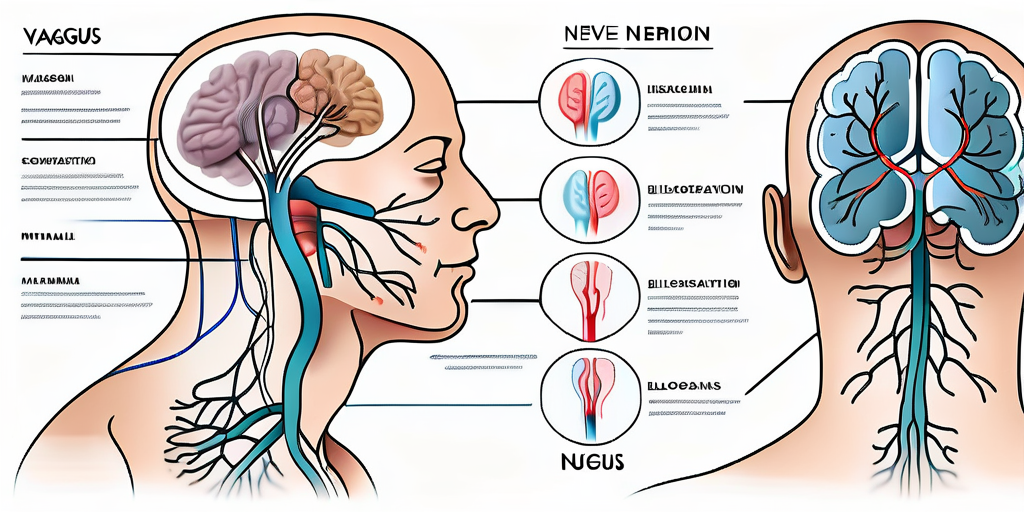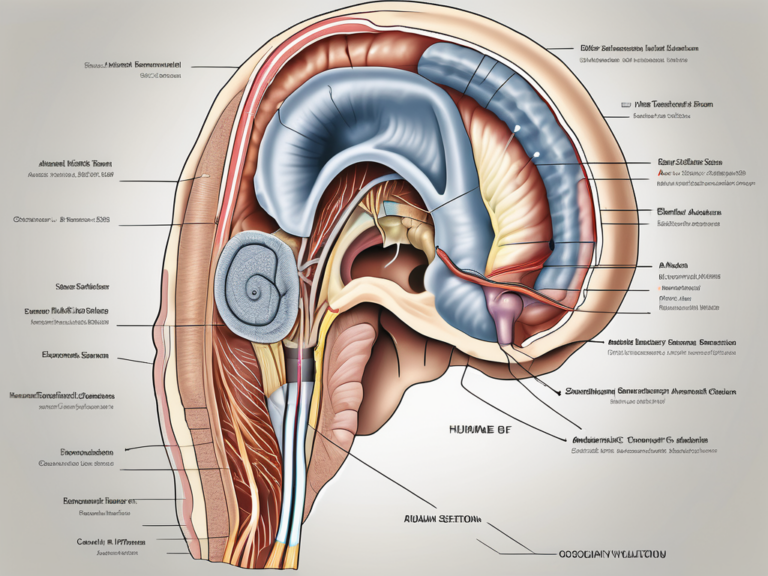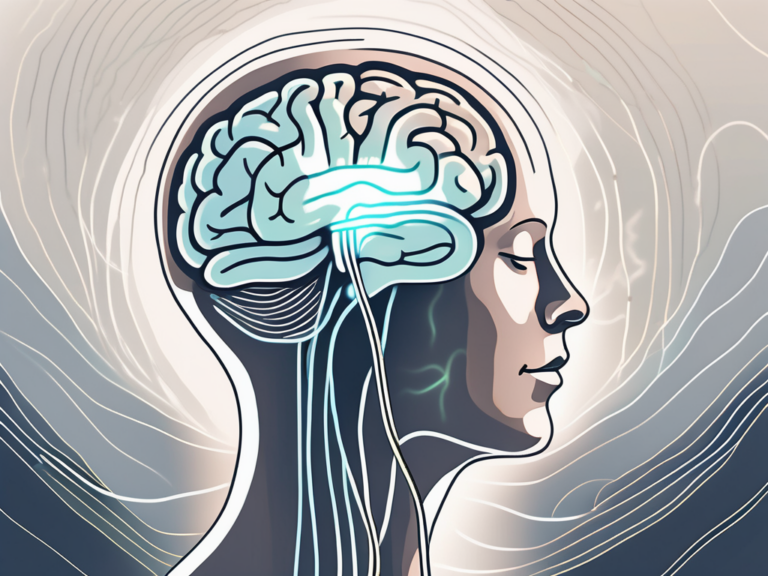meditation vagus nerve
The vagus nerve is an important part of the human body’s nervous system. It plays a crucial role in regulating various bodily functions and is intricately connected to the brain. In recent years, there has been growing interest in the relationship between meditation and the vagus nerve. This article aims to explore the science behind this connection and understand the potential benefits of using meditation as a tool for vagus nerve stimulation.
Understanding the Vagus Nerve
The vagus nerve, also known as the tenth cranial nerve, is the longest cranial nerve in the human body. It originates in the brainstem and travels through the neck and chest, branching off into various organs such as the heart, lungs, and digestive system. The vagus nerve is responsible for regulating a wide range of bodily functions, including heart rate, digestion, and immune response.

The Role of the Vagus Nerve in the Body
One of the primary functions of the vagus nerve is to promote a state of relaxation and rest in the body. When the vagus nerve is activated, it triggers the release of neurotransmitters that induce a sense of calm and reduce stress levels. This activation can lead to a decrease in heart rate, blood pressure, and overall tension in the body.
But did you know that the vagus nerve also plays a crucial role in the digestive system? It controls the movement of food through the gastrointestinal tract, ensuring that it is properly digested and absorbed. Additionally, the vagus nerve stimulates the release of digestive enzymes and bile, which are essential for breaking down food and facilitating nutrient absorption.
Furthermore, the vagus nerve is involved in regulating the body’s inflammatory response. By stimulating the release of anti-inflammatory molecules, it helps to maintain balance within the immune system and prevent excessive inflammation. This is particularly relevant in the context of chronic diseases where inflammation plays a significant role.
The Connection Between the Vagus Nerve and the Brain
The vagus nerve acts as a two-way communication channel between the brain and the body. It constantly relays information from various organs to the brain, allowing the brain to monitor and regulate their functioning. Additionally, the vagus nerve carries signals from the brain back to the body, influencing bodily functions and responses.
Research has shown that the vagus nerve plays a key role in the brain’s ability to regulate emotions and manage stress. Stimulation of the vagus nerve has been found to activate specific areas in the brain responsible for emotional regulation, leading to a reduction in anxiety and depressive symptoms.
Moreover, recent studies have uncovered an intriguing connection between the vagus nerve and memory formation. It has been found that the vagus nerve plays a crucial role in the consolidation of memories, particularly those associated with emotional experiences. By modulating the release of neurotransmitters in the brain, the vagus nerve helps to strengthen the neural connections involved in memory formation, enhancing our ability to remember and recall information.
In conclusion, the vagus nerve is a remarkable component of our nervous system, with its extensive reach and multifaceted functions. From regulating heart rate and digestion to influencing emotions and memory, this cranial nerve plays a vital role in maintaining our overall well-being. Understanding the intricate workings of the vagus nerve can provide valuable insights into the complex interplay between our brain and body.
The Science of Meditation
Meditation is a centuries-old practice that involves training the mind to achieve a state of focused attention and heightened awareness. While meditation is often associated with spiritual or religious practices, it has gained significant attention in the scientific community due to its potential health benefits.
But what exactly happens in the brain when we meditate? Neuroscientific research has provided us with fascinating insights into the effects of meditation on the brain. Studies using neuroimaging techniques, such as functional magnetic resonance imaging (fMRI), have shown that long-term meditators exhibit increased activity in regions associated with attention, emotional regulation, and self-awareness.
These findings suggest that meditation can actually reshape the brain. In fact, meditation has been found to increase the density of gray matter in certain brain areas, specifically those involved in memory, learning, and emotional processing. These structural changes may contribute to the improvements seen in cognitive functions and emotional well-being reported by regular meditators.
The Physical and Mental Benefits of Meditation
Aside from its impact on brain structure and function, meditation has been linked to a wide range of physical and mental health benefits. Regular meditation practice has been shown to reduce stress, anxiety, and symptoms of depression. It can improve sleep quality, promote relaxation, and enhance overall feelings of well-being.
But the benefits of meditation don’t stop there. Research has also found that meditation has positive effects on cardiovascular health. Studies suggest that meditation can lower blood pressure, reduce the risk of heart disease, and improve heart rate variability – a measure of the heart’s ability to adapt to changes in the environment.
Furthermore, meditation has been found to boost the immune system. A study published in the journal Psychosomatic Medicine found that individuals who practiced meditation had higher levels of antibodies compared to non-meditators. These antibodies play a crucial role in fighting off infections and diseases, indicating that meditation may have a protective effect on our immune system.
Additionally, meditation has been shown to enhance creativity and problem-solving skills. By quieting the mind and fostering a state of deep concentration, meditation can unlock our creative potential and help us think outside the box. This is why many artists, writers, and innovators incorporate meditation into their daily routines.
So whether you’re looking to reduce stress, improve your cognitive abilities, or enhance your overall well-being, meditation offers a wealth of benefits backed by scientific research. It’s a practice that not only nourishes the mind but also has a profound impact on our physical health. So why not give it a try and experience the transformative power of meditation for yourself?
The Intersection of Meditation and the Vagus Nerve
The practice of meditation appears to have a direct impact on the vagus nerve, leading to its stimulation and potential health benefits. The calming and focusing effects of meditation can activate the vagus nerve, promoting relaxation and restoring balance within the body.
The Impact of Meditation on Vagus Nerve Stimulation
Studies have shown that meditation practices, such as deep breathing, loving-kindness meditation, and mindfulness meditation, can increase vagal tone. Vagal tone refers to the strength and effectiveness of vagus nerve activity. Higher vagal tone is associated with better overall health, improved emotional resilience, and a reduced risk of developing chronic diseases.
Meditation-induced vagus nerve stimulation can lead to a multitude of positive effects on the body. It can decrease heart rate and blood pressure, improve digestion, enhance immune function, and facilitate a state of calm and relaxation.
How Meditation Can Improve Vagal Tone
Meditation helps improve vagal tone by activating the parasympathetic nervous system, which is responsible for promoting rest, relaxation, and recovery. Through rhythmic breathing, visualization, and focused attention, meditation activates the relaxation response, triggering the release of neurotransmitters that enhance vagus nerve activity.
The regular practice of meditation can strengthen and train the vagus nerve, allowing it to respond more effectively to stressors and adapt to different situations. This increased flexibility and resilience can improve overall health and well-being.
Furthermore, research suggests that meditation can also have a positive impact on the gut-brain axis, which is the bidirectional communication network between the gut and the brain. The vagus nerve plays a crucial role in this axis, transmitting signals between the gut and the brain. By stimulating the vagus nerve, meditation can enhance this communication, leading to improved gut health and cognitive function.
In addition to its effects on the gut-brain axis, meditation has been found to influence the release of neurotransmitters such as serotonin and dopamine. These neurotransmitters play a key role in regulating mood, emotions, and overall well-being. By promoting the release of these “feel-good” chemicals, meditation can contribute to a more positive emotional state and a greater sense of happiness and contentment.
Techniques for Vagus Nerve Stimulation Through Meditation
There are several techniques that individuals can incorporate into their meditation practice to specifically target vagus nerve stimulation and enhance its benefits.
But let’s dive deeper into these techniques and explore the fascinating world of vagus nerve stimulation.
Breathing Techniques for Vagal Stimulation
Deep breathing exercises, such as diaphragmatic breathing or alternate nostril breathing, have been shown to directly stimulate the vagus nerve. By taking slow, deep breaths and focusing on extending the exhale, individuals can activate the relaxation response and enhance vagal tone.
But did you know that the vagus nerve is not only responsible for relaxation but also plays a crucial role in regulating various bodily functions? It is like the conductor of an orchestra, coordinating the symphony of our body’s systems.
Another breathing technique known as resonance frequency breathing involves inhaling and exhaling at a specific rhythm that resonates with the natural frequency of the vagus nerve. This technique has been found to produce significant improvements in heart rate variability and overall stress levels.
Imagine your breath syncing with the rhythm of this powerful nerve, creating a harmonious dance within your body, promoting balance and well-being.
Mindfulness Practices for Vagus Nerve Health
Mindfulness meditation is a practice that involves bringing one’s attention to the present moment without judgment. By cultivating moment-to-moment awareness, individuals can develop a greater sense of self-regulation and emotional resilience, both of which are closely tied to vagal tone.
But let’s take a moment to appreciate the intricate relationship between mindfulness and the vagus nerve. As we become more mindful, we start to notice the subtle sensations and signals that our body sends us, like a gentle whisper from the vagus nerve, guiding us towards balance and well-being.
Incorporating mindfulness into daily life by consciously paying attention to sensory experiences, thoughts, and emotions can help individuals become more attuned to their body’s signals and regulate their responses effectively. This heightened self-awareness can positively influence the functioning of the vagus nerve.
So, as you embark on your journey of vagus nerve stimulation through meditation, remember that you are not only enhancing your relaxation response but also nurturing a profound connection with your body’s inner wisdom.
The Long-Term Effects of Meditation on the Vagus Nerve
Consistent meditation practice can have profound long-term effects on the vagus nerve and overall vagal tone. By repeatedly activating the relaxation response and enhancing vagal activity, individuals may experience lasting improvements in their physical and mental well-being.

Potential Health Benefits of Regular Vagal Stimulation
Regular vagus nerve stimulation through meditation has been associated with a wide range of health benefits. Improved vagal tone may lead to enhanced cardiovascular health, reduced inflammation, better digestion, and a strengthened immune system.
But the benefits don’t stop there. Research has also shown that consistent meditation can have a positive impact on mental health. By stimulating the vagus nerve, meditation can help regulate mood and reduce symptoms of anxiety and depression. This is particularly significant considering the rising rates of mental health disorders worldwide.
In addition, individuals with conditions such as anxiety disorders, depression, irritable bowel syndrome (IBS), or chronic pain may find relief through regular vagal stimulation. Studies have shown promising results in reducing symptoms and improving overall quality of life in these populations.
The Role of Consistent Meditation in Vagus Nerve Health
Consistency is key when it comes to reaping the full benefits of meditation on vagus nerve health. Incorporating meditation into a daily routine and making it a habit allows individuals to build resilience, enhance vagal tone, and maintain physiological and emotional well-being over the long term.
But how exactly does meditation impact the vagus nerve? Well, it turns out that the relaxation response triggered by meditation activates the parasympathetic nervous system, which is responsible for the rest and digest response. This, in turn, stimulates the vagus nerve, leading to a cascade of positive effects throughout the body.
Establishing a regular meditation practice may require patience and perseverance. However, the potential rewards of improved vagus nerve function and overall health make it a worthwhile endeavor. So, whether you’re a beginner or an experienced meditator, dedicating time each day to cultivate mindfulness and stimulate your vagus nerve can have profound and lasting effects on your well-being.
Overcoming Challenges in Meditation for Vagus Nerve Stimulation
While meditation can be a powerful tool for vagus nerve stimulation, it is not without its challenges. It is essential to be aware of common obstacles that may hinder progress and implement strategies to overcome them.

Common Obstacles in Meditation Practices
One of the most common challenges individuals face in meditation is a busy and distracted mind. Thoughts, worries, and external distractions can make it difficult to maintain focus and achieve a deep meditative state.
Imagine sitting down to meditate, hoping to find inner peace and tranquility, only to be bombarded by a relentless stream of thoughts. Your mind jumps from one topic to another, making it feel like you’re trapped in a never-ending thought carousel. It can be frustrating and discouraging, but rest assured, you are not alone in this experience.
Another obstacle is finding the time and space to meditate regularly. Many individuals lead busy lives, and carving out dedicated time for meditation can be challenging. Additionally, creating a quiet and peaceful environment conducive to meditation may not always be feasible.
Picture yourself in a bustling city, surrounded by the constant noise of traffic and the hustle and bustle of people. Finding a moment of silence seems like an impossible task. Yet, amidst this chaos, there is still hope. With a little creativity and flexibility, you can discover pockets of tranquility in unexpected places.
Tips for Effective and Consistent Meditation
To overcome these challenges, it is helpful to start with realistic expectations and gradually increase the duration and frequency of meditation sessions. Starting with shorter sessions and gradually building up can make it more manageable and sustainable.
Think of meditation as a marathon rather than a sprint. Just as you wouldn’t expect to run a full marathon without training, it’s important to approach meditation with patience and a long-term perspective. By starting small and gradually increasing your meditation practice, you’ll build the mental stamina needed to overcome distractions and find deeper states of relaxation.
Establishing a consistent routine can also contribute to greater success in meditation. Setting aside a specific time and place for practice, even if it’s just a few minutes each day, helps to reinforce the habit and makes it easier to incorporate meditation into one’s lifestyle.
Imagine having a designated meditation corner in your home, a sacred space where you can retreat and find solace. It could be a cozy nook with soft cushions, a flickering candle, and a gentle aroma of incense. Creating this space not only provides a physical reminder to meditate but also signals to your mind that it’s time to let go and embrace stillness.
Additionally, utilizing guided meditation or mindfulness apps can provide structure and support for beginners or those struggling with maintaining focus during meditation. These resources offer various techniques, including specific practices for vagus nerve stimulation.
Imagine having a wise and compassionate guide leading you through your meditation journey. With their soothing voice and gentle instructions, they help you navigate the challenges of a busy mind and create a space for deep relaxation. Guided meditations can be a valuable tool, especially when you’re just starting or feeling overwhelmed.
Finally, cultivating a mindset of non-judgment and self-compassion is crucial in meditation. Accepting that thoughts may arise during practice without becoming attached to them or labeling them as distractions can foster a more relaxed and enjoyable meditation experience.
Imagine sitting in meditation, observing your thoughts as if they were passing clouds in the sky. Instead of getting caught up in their stories or judging their validity, you simply acknowledge their presence and let them drift away. By cultivating this mindset of non-judgment and self-compassion, you create a safe and nurturing space for your practice.
In conclusion, the practice of meditation offers a unique opportunity to stimulate and enhance the functioning of the vagus nerve. By incorporating various techniques for vagus nerve stimulation into meditation practice, individuals can potentially benefit from improved overall health, stress reduction, emotional well-being, and better resilience in the face of challenges. With consistency, patience, and an open mind, meditation can become a powerful tool for harnessing the potential of the vagus nerve and achieving a greater sense of balance and well-being in life.






